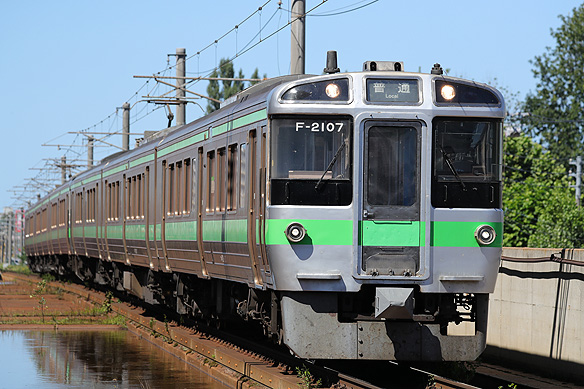Background and overview
In July 2010, JR Hokkaido modified set F-21 of the 721-0 series to improve
reliability following frequent traction system failures. The refurbishment
included replacement of the traction system with a variable-frequency drive
and structural upgrades to the carbody. The modified set was reclassified
as the 721-2100 series. As part of the conversion, the powered end car
(class Kumoha721-0) was reconfigured into a trailer-end car (class Kuha721-2200).
The resulting formation, converted from set F-7, consists of one powered
intermediate car and two trailer-end cars.
Car body
Renovation work included replacement of corroded floor panels, aged floor
sheets, and thermal insulation materials. Moha721-2107 was fitted with
1 mm-thick stainless steel cover plates between underfloor equipment to
reduce surface undulation and prevent snow and ice accumulation. Anti-fall
plates were newly installed between vehicles, excluding the cab ends.
Bogies
The powered bogies are designated N-DT721. Kuha721-2107 is fitted with
N-TR721 trailer bogies, while Kuha721-2207 employs N-DT721T bogies, which
are converted from powered bogies originally carried by a Kumoha721 vehicle.
All bogies feature bolster-less secondary air suspension, conical multilayer
rubber spring journal supports, and a Watts linkage draw gear. Power transmission
utilizes Twin Disc (TD) flexible joints with deflecting plates made of
carbon-fiber reinforced plastic (CFRP). The gear ratio was changed to 5.19
to enhance acceleration performance at medium to high speeds, with a maximum
service speed of 130 km/h. All bogies employ double-tread brake rigging
with enhanced-adhesion alloy cast iron brake shoes.
Traction unit and ancillary equipments
Moha721-2107 is equipped with traction system N-CI721-2, which controls
four AC induction motors (N-MT731), each rated at 230 kW per truck. The
system comprises a three-level PWM converter and a two-level variable-frequency
drive (VFD), both employing insulated gate bipolar transistors (IGBTs).
The original traction resistor unit for rheostatic braking, previously
installed on Kumoha721-7, was removed.
A travelling wind self-cooled traction transformer (N-TM721A-AN) is mounted beneath the floor. The air compressor previously installed on Kuha721-2107 was replaced with unit N-MH1045-C2000ML, and the auxiliary power supply was upgraded to N-APS721C, rated at 8?kVA. The braking system is an electric-command type featuring regenerative and holding brake functions, with control logic prioritizing trailer vehicles.
Operations
The 721-2100 series is currently assigned to regional services on the Hakodate,
Chitose, and Sassho Lines, operating alongside the 731 and 733 series. |
|
| Technical Data |
| Items |
Data |
| Supply Voltage |
20,000 V AC, 50 Hz |
| Service
speed, etc. |
Acceleration: 2.4 km/h/s Deceleration: 4.1 km/h/s Service speed: 120 km/h |
| Length |
20,800 mm |
| Width |
2,954 mm |
| Height |
3,670 mm |
| Bogie |
N-DT721 (powered) N-TR721, N-DT721T (trailer) |
| Collector |
N-PS785 |
| Traction
motor |
N-MT721A (250 kW) |
| Gear ratio |
5.6 |
| Transformer |
N-TM721A-AN |
| Traction system |
Converter and variable frequency drive on truck basis: N-CI721-1 |
| Air conditioner |
N-AU721 (20,000 kcal/h×1) |
| Designed
by |
JR Hokkaido |
|
|

